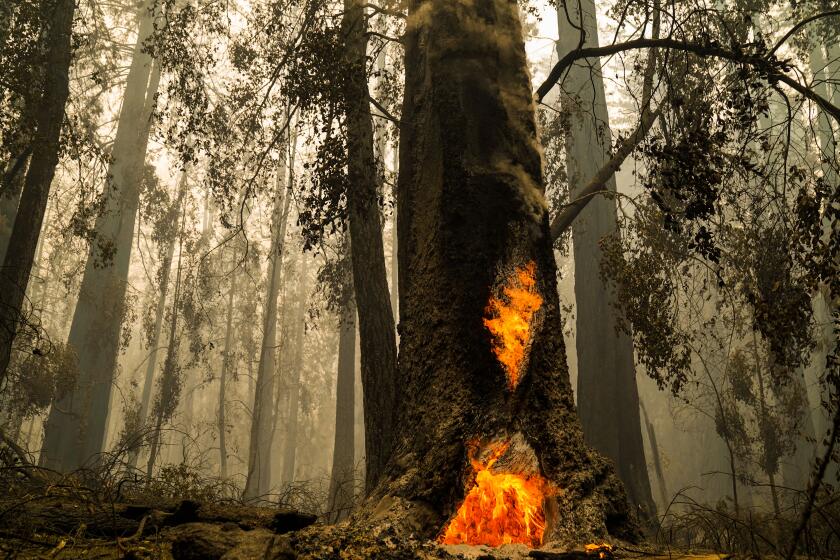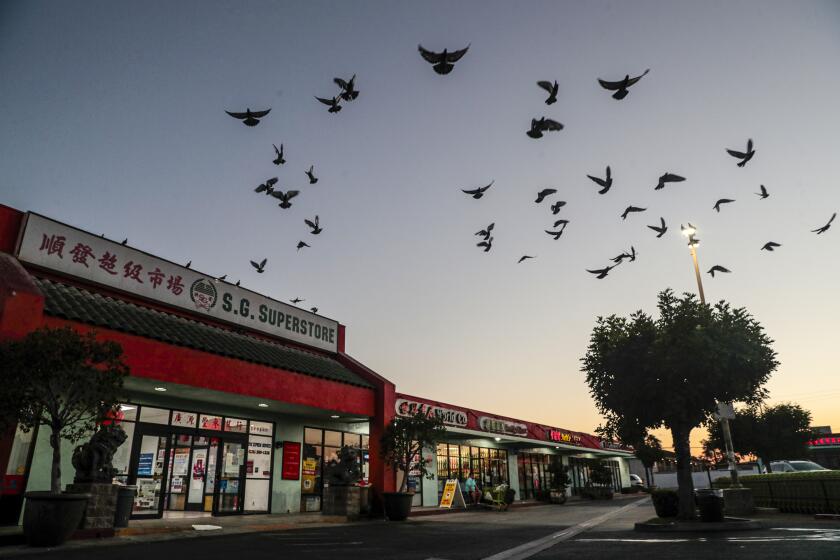Editorial: Wildfires and soaring temperatures — the hellscape scientists warned us about is here

- Share via
After an extended weekend of wildfires, part of an early fire season that has already seen a record 2 million acres burned and Death Valley-like temperatures smothering the San Fernando Valley, Californians would be right to wonder whether we are living in a hellscape. We are not, it’s safe to say. But we are living in the future that climate scientists have been trying to warn us about for years now.
No, climate change did not start the El Dorado fire Saturday near Yucaipa. That, authorities report, was caused by celebrants setting off some pyrotechnics during a gender-reveal party. (What the hell were they thinking?) And climate change did not spark the Bobcat fire the next day in the San Gabriel Mountains north of Monrovia. But climate change has played a role in the conditions — in particular, the drier, hotter air and deeper droughts creating more flammable ecosystems — that are making these fires bigger and more dangerous.
The fires here are part of a broad burning of wildlands in the West, which occurred naturally before densifying human settlements and the non-native plants they introduced began changing the balance of nature. The Insurance Information Institute counted almost 40,000 wildfires in the country this year through Aug. 31, compared with fewer than 33,600 for the same time frame in 2019.
Fire season has barely begun and California has already had two of the three largest wildfires in its recorded history. The effects of climate change are here, now.
That uptick in the number of fires may be a blip, or it may be a sign of a worrisome new trend. The Congressional Research Service reported last year that an average of 6.9 million acres have burned each year since 2000, with an annual average of 71,300 wildfires. That’s more than double average annual acreage that went up in flames in the 1990s, even though in that decade there were more fires each year. In other words, over the last three decades the West has trended toward fewer fires, but the ones that have erupted have caused more damage.
This is the kind of change that climate experts told us to expect. But there is more going on than the smoke in our skies.
The population of Louisiana’s bayou region has shifted inland after levees and other flood-protection projects disrupted the Mississippi River’s ability to replenish land that’s slowly (and naturally) sinking, paradoxically leaving it more vulnerable to flooding from stronger and more frequent hurricanes. A state report last year estimated that “1,900 square miles have been lost in Louisiana since the 1930s, and an additional 4,120 square miles could be lost over the next 50 years…. Louisiana is in the midst of an existential crisis.”
In fact, all of the world’s low-lying coastal regions face existential danger from rising seas, imperiling the homes of more than 300 million people. By one estimate, 40% of the U.S. population lives in places susceptible to a sea level rise of just three feet, predicted in some models by the end of the century.
In the midst of the coronavirus outbreak, and against the deafening noise of the presidential election, few people may have noticed a study released last month reporting that the ice sheet covering Greenland is disappearing faster than had been predicted, and that it may have already passed a tipping point. In June, a Siberian town recorded the highest-ever temperature in the Arctic: 100.4 degrees. In Alaska, melting permafrost and decreased coastal ice have led to significant erosion, forcing two settlements to pack up and move farther inland.
The Times begins rolling out its 2020 endorsements with time to read, reflect, critique, embrace or dispute before ballots are mailed starting Oct. 5.
So we haven’t, as a species, sufficiently heeded the warnings of our scientists, and now we are seeing the costs of that intransigence. There is no longer — if there ever really was — any plausible deniability that the burning of fossil fuels for energy heats up the oceans and the atmosphere, creating a cycle of interactions that compound the problem.
We need to end this reliance on fossil fuels if we’re going to have any hope of mitigating the damage we have already done to the global environment, and to ourselves. We need to stop building communities in places that we know will burn. We need to stop doing stupid things like lighting off fireworks in wildland areas. We need to plan for how rising seas will affect not only seaside settlements, but coastal aquifers subject to the intrusion of salty ocean water. We need to better and more forthrightly take on the responsibility to fix what we have broken. We need to do so much that it can be overwhelming, and dispiriting. But we dare not succumb to it. Wildfires don’t care.
More to Read
A cure for the common opinion
Get thought-provoking perspectives with our weekly newsletter.
You may occasionally receive promotional content from the Los Angeles Times.











